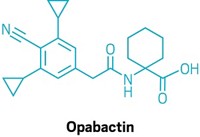Advertisement
Grab your lab coat. Let's get started
Welcome!
Welcome!
Create an account below to get 6 C&EN articles per month, receive newsletters and more - all free.
It seems this is your first time logging in online. Please enter the following information to continue.
As an ACS member you automatically get access to this site. All we need is few more details to create your reading experience.
Not you? Sign in with a different account.
Not you? Sign in with a different account.
ERROR 1
ERROR 1
ERROR 2
ERROR 2
ERROR 2
ERROR 2
ERROR 2
Password and Confirm password must match.
If you have an ACS member number, please enter it here so we can link this account to your membership. (optional)
ERROR 2
ACS values your privacy. By submitting your information, you are gaining access to C&EN and subscribing to our weekly newsletter. We use the information you provide to make your reading experience better, and we will never sell your data to third party members.
Biological Chemistry
Researchers use artificial evolution to combat insect pesticide resistance
Method produces modified Bt toxins that potently target new receptor on insect gut cells
by Stu Borman
April 28, 2016
| A version of this story appeared in
Volume 94, Issue 18

If you garden, you probably know that insects like to eat your fruits and vegetables before you do. Farmers know that too, and one way they address the wily insect pests is by engineering plants to make insecticidal proteins called Bt toxins, derived from the bacterium Bacillus thuringiensis. Billions of dollars’ worth of Bt toxin-producing crops are protected from insect destruction each year.
But increasing numbers of insects have evolved resistance to Bt toxins, threatening these agricultural gains. Researchers have now devised an innovative countermeasure that could complement other strategies for combatting insect resistance.
David R. Liu of Harvard University and coworkers at Harvard, Cornell University, and the agrochemical firm Monsanto demonstrated the approach on a Bt toxin called Cry1Ac, which is active against some of the most important insect pests and therefore widely used across the globe. Cry1Ac and other Bt toxins bind to specific protein receptors on the surface of insect gut cells. The interaction causes pores to form in the cell membranes, leading to cell death and, ultimately, insect death. In resistant insects, the receptors are mutated, poorly expressed, or missing, rendering the toxins useless.
So the research team used phage-assisted continuous evolution (PACE), a system Liu’s group developed earlier, to create a modified Bt toxin to which insects are not yet resistant. The researchers pinpointed evolved toxins that bind with high affinity to a different insect gut receptor protein than those Cry1Ac normally hits in cabbage looper, a caterpillar pest (Nature 2016, DOI: 10.1038/nature17938).
The evolved toxins kill a Cry1Ac-resistant cabbage looper up to 335 times as potently as Cry1Ac does and nearly as effectively as conventional Bt toxins kill nonresistant insects. Although insects could develop resistance to the evolved toxins, PACE works quickly enough that scientists could evolve multiple versions of the new toxins and use them individually or in combination to extend the strategy’s effectiveness.
Bt toxin expert Alejandra Bravo of the National Autonomous University of Mexico comments that developing toxins that recognize alternative receptors is a novel idea that could turn out to represent “a breakthrough” in the field.
Insect resistance specialist Bruce Tabashnik of the University of Arizona agrees that the approach is “innovative” but notes that “it remains to be seen if the method can be applied to resistant insects other than the single strain of cabbage looper tested in the study.”





Join the conversation
Contact the reporter
Submit a Letter to the Editor for publication
Engage with us on Twitter